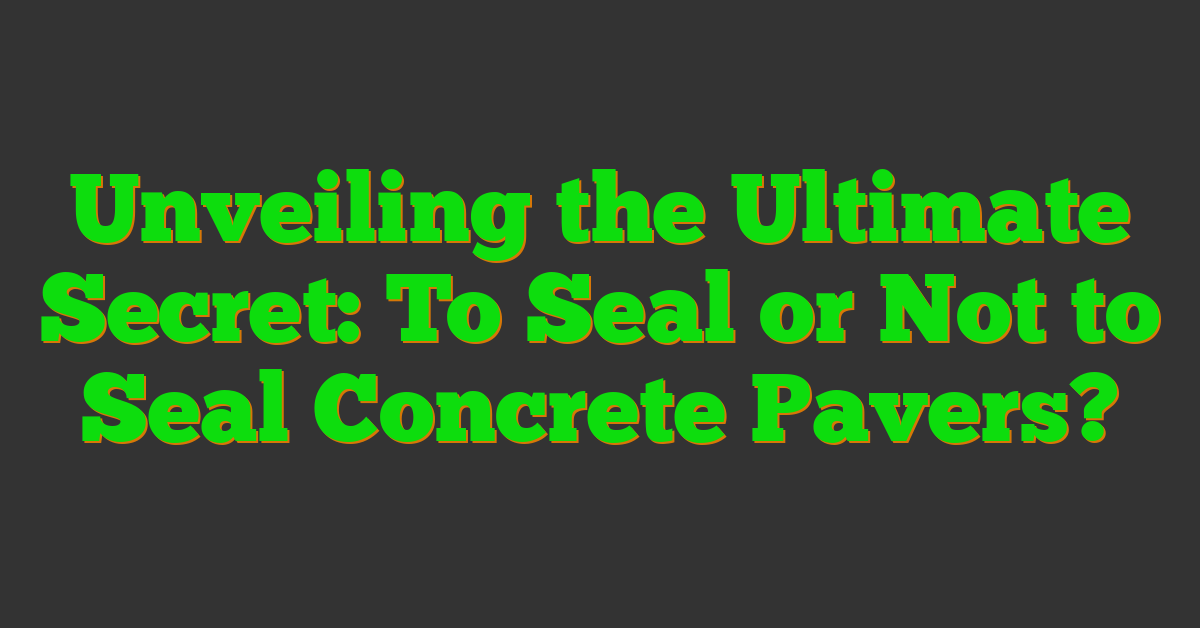So, you’re thinking about sprucing up your outdoor space by adding some pavers, but you’re wondering, can you lay pavers over dirt? Well, we’ve got you covered! When it comes to transforming your backyard or garden, laying pavers can be a fantastic way to create a stylish and functional area for relaxing or entertaining.

Whether you’re planning a cozy patio or a winding garden path, laying pavers over dirt can be a doable DIY project with the right guidance. By understanding the basics of proper preparation and installation, you can turn that bare patch of dirt into a beautiful paved surface in no time.
Understanding the Basics of Laying Pavers
The Role of a Solid Foundation
When considering laying pavers, one of the fundamental aspects we always emphasize is establishing a firm foundation. A solid base ensures the longevity and durability of the paver installation. Before laying any pavers, we inspect the area to assess the soil condition and make necessary preparations. It’s essential to remove any vegetation, rocks, or debris from the site to create a clean slate for the paver installation. Compacting the soil and adding a base material like gravel or sand provides stability and prevents shifting over time. By prioritizing a sturdy foundation, we guarantee a professional and long-lasting paver surface.
Types of Pavers for Different Surfaces
In our experience as landscape designers, we encounter various types of pavers suitable for different surfaces and design preferences. Concrete pavers are versatile and come in a wide range of colors, shapes, and sizes, making them ideal for various projects. For a more natural look, stone pavers offer a classic aesthetic and blend well with garden landscapes. Brick pavers, on the other hand, provide a timeless charm and are perfect for creating traditional pathways or patios. By understanding the characteristics of each paver type, we can recommend the best option based on the desired outcome and the existing outdoor environment. Our expertise lies in selecting the right pavers that not only enhance the visual appeal but also withstand the test of time.
Preparing the Ground for Pavers
As landscape designers, we understand that preparing the ground properly is crucial before laying pavers to ensure a stable and long-lasting outdoor surface. Let’s dive into the essential steps to take before embarking on your paver installation project.
Assessing the Dirt Condition
Before laying pavers over dirt, our first task is to assess the condition of the soil. We check for any drainage issues, the presence of organic materials, and the overall stability of the dirt. It’s essential to ensure that the soil is well-drained and compacted to prevent any future shifting of the pavers. By examining the dirt condition, we can determine the necessary steps to create a solid base for the pavers.
Ground Leveling and Compaction
Once we have assessed the dirt condition, the next step is to level the ground and compact the soil. We use appropriate tools such as a shovel, rake, and plate compactor to achieve a uniform surface with proper slope for water drainage. Leveling the ground is essential to prevent uneven paver installation and ensure a smooth and visually appealing finish. Compacting the soil is equally important as it helps create a stable foundation that reduces the risk of settling or shifting over time.
By focusing on assessing the dirt condition and properly leveling and compacting the ground, we set the stage for a successful paver installation project that not only enhances the aesthetic appeal of outdoor spaces but also ensures durability and functionality for years to come.
The Pros and Cons of Laying Pavers Over Dirt
As landscape designers, we understand the allure of transforming outdoor spaces using pavers laid over dirt. Let’s dive into the advantages and challenges of this approach to help you make an informed decision.
Advantages of Direct Dirt Installation
When considering laying pavers over dirt, several advantages come to mind. Firstly, this method can be a cost-effective solution, as it eliminates the need for excavating existing surfaces, which can save both time and money. Additionally, direct dirt installation offers increased flexibility in changing the layout or design of your outdoor space, allowing for adjustments without the constraints of a concrete base.
Another benefit of laying pavers over dirt is the ease of installation. This DIY-friendly approach can be undertaken by homeowners with basic skills and tools, making it an accessible project for many. Moreover, pavers placed over dirt can adapt better to ground movement compared to rigid surfaces, reducing the risk of cracking or shifting over time.
By opting for direct dirt installation, you can create a more natural aesthetic for your outdoor area. The pavers blend seamlessly with the earth beneath, offering a rustic charm that complements gardens or backyard landscapes beautifully. This approach can enhance the overall feel of your outdoor space, adding warmth and character to your design.
Challenges and Longevity Concerns
Despite the advantages, laying pavers over dirt also presents certain challenges and longevity concerns that should not be overlooked. One primary issue is the potential for uneven settling of pavers over time, especially in areas with varying soil conditions. This can lead to an uneven surface, affecting both the visual appeal and functionality of the paved area.
Furthermore, without a solid base like gravel or sand, pavers placed directly on dirt may be more susceptible to shifting and movement. Factors such as extreme weather conditions, heavy foot traffic, or inadequate drainage can exacerbate this problem, compromising the stability and longevity of the paved surface.
Another challenge to consider is the risk of weed growth between pavers when laid over dirt. Without proper base materials and adequate weed prevention measures, weeds can penetrate the surface, detracting from the overall aesthetics of the paved area and requiring additional maintenance to address.
Understanding the pros and cons of laying pavers over dirt is essential to determine whether this approach aligns with your design vision and practical considerations for your outdoor space. By weighing these factors carefully, you can make an informed choice that ensures a durable, visually appealing, and long-lasting paved surface.
Step-by-Step Guide to Installing Pavers Over Dirt
Choosing Your Pavers
When selecting pavers for laying over dirt, we recommend opting for durable materials like concrete or brick pavers. These types of pavers can withstand outdoor conditions and provide a stable surface for various activities. Consider the color, shape, and texture of the pavers to complement the surrounding landscape and achieve the desired aesthetic appeal. It’s essential to choose pavers that suit the intended use of the space and align with your design preferences.
Gathering Necessary Tools and Materials
Before starting the installation process, gather the essential tools and materials required for laying pavers over dirt. You’ll need items such as a shovel, tape measure, landscape fabric, gravel, sand, a tamper, and the selected pavers. Ensure you have all the necessary equipment on hand to streamline the installation process and avoid interruptions. Proper preparation with the right tools and materials is key to a successful paver installation over dirt.
Laying and Securing the Pavers
To begin the installation, prepare the dirt surface by leveling it and removing any debris or vegetation. Next, lay down a base layer of gravel and compact it using a tamper to create a stable foundation. Place a layer of landscape fabric over the gravel to prevent weed growth and promote drainage. Then, add a layer of sand for leveling before laying the pavers in the desired pattern. Secure the pavers in place by gently tapping them with a rubber mallet to ensure they are flush and properly set. Finally, fill the gaps between pavers with sand to stabilize the surface and complete the installation process.
« When to Seal Pavers: The Ultimate Guide to Maintaining Your Outdoor Space Like a Pro Discover the Ultimate Ant-Elimination Secrets for Pavers »
Maintaining Pavers Laid Over Dirt
Regular Cleaning and Maintenance
As landscape designers, we understand the importance of regular cleaning and maintenance to ensure that pavers laid over dirt retain their beauty and functionality. To preserve the aesthetic appeal of your outdoor space, it’s essential to establish a routine for cleaning your pavers. We recommend sweeping the surface regularly to remove debris such as leaves, dirt, and twigs that can accumulate between the pavers. This simple practice not only enhances the visual appeal but also prevents the growth of weeds and moss, maintaining a neat and polished look.
In addition to routine sweeping, we advise using a gentle cleanser and a brush to eliminate any stains or stubborn dirt that may have built up over time. Avoid harsh chemicals that can damage the pavers or surrounding vegetation. Regularly inspecting the pavers for any signs of shifting, settling, or damage is also crucial. Addressing these issues promptly can prevent more extensive damage and ensure the longevity of your paved surface. By incorporating these maintenance practices into your regular upkeep routine, you can enjoy a beautiful and well-maintained outdoor space for years to come.
When to Opt for Professional Help
While regular maintenance tasks can be managed independently, certain situations may require professional intervention to resolve more complex issues effectively. As experienced landscape designers, we recommend seeking professional help if you notice significant shifting or sinking of the pavers, indicating a potential underlying problem with the base materials or installation. Professional paver maintenance services have the expertise and specialized equipment to assess the situation accurately and provide suitable solutions to rectify the issue.
In cases where the pavers show signs of severe damage, such as cracks or breakage, it’s advisable to consult with professionals to determine the best course of action for repair or replacement. Professional paver repair and restoration services can address structural issues, restore the integrity of the paved surface, and enhance its longevity. By entrusting these complex tasks to skilled professionals, you can ensure the durability and longevity of your paved area while maintaining its visual appeal and functionality.
Conclusion
Maintaining pavers laid over dirt is essential for their longevity and appeal. Regular cleaning, gentle care for stains, and prompt inspection for any issues are key to preserving their beauty and functionality. Professional assistance should be sought for significant problems to ensure proper repair or replacement, safeguarding the paved area’s visual charm. Remember, with the right maintenance, your pavers can continue to enhance your outdoor space for years to come.
















